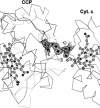Crystal structure and characterization of a cytochrome c peroxidase-cytochrome c site-specific cross-link
- PMID: 15071191
- PMCID: PMC395902
- DOI: 10.1073/pnas.0306708101
Crystal structure and characterization of a cytochrome c peroxidase-cytochrome c site-specific cross-link
Abstract
A specific covalently cross-linked complex between redox partners yeast cytochrome c peroxidase (CCP) and cytochrome c (cyt. c) has been made by engineering cysteines into CCP and cyt. c that form an intermolecular disulfide bond in high yield. The crystal structure of the cross-linked complex has been solved to 1.88-A resolution and closely resembles the structure of the noncovalent complex [Pellitier, H. & Kraut, J. (1992) Science 258, 1748-1755]. The higher resolution of the covalent complex has enabled the location of ordered water molecules at the peroxidase-cytochrome c interface that serve to bridge between the two proteins by hydrogen bonding. As in the noncovalent complex, direct electrostatic interactions between protein groups appear not to be critical in complex formation. UV-visible spectroscopic and stopped-flow studies indicate that CCP in the covalent complex reacts normally with H(2)O(2) to give compound I. Stopped-flow kinetic studies also show that intramolecular electron transfer between the cross-linked ferrocytochrome c and the Trp-191 cation radical site in CCP compound I occurs fast and is nearly complete within the dead time ( approximately 2 ms) of the instrument. These results indicate that the structure of the covalent complex closely mimics the physiological electron transfer complex. In addition, single-turnover and steady-state experiments reveal that CCP compound I in the covalent complex oxidizes exogenously added ferrocytochrome c at a slow rate (t(1/2) approximately 2 min), indicating that CCP does not have a second independent site for physiologically relevant electron transfer.
Figures





Similar articles
-
Probing the cytochrome c peroxidase-cytochrome c electron transfer reaction using site specific cross-linking.Biochemistry. 1996 Apr 16;35(15):4837-45. doi: 10.1021/bi952935b. Biochemistry. 1996. PMID: 8664274
-
Constraints on the Radical Cation Center of Cytochrome c Peroxidase for Electron Transfer from Cytochrome c.Biochemistry. 2016 Aug 30;55(34):4807-22. doi: 10.1021/acs.biochem.6b00262. Epub 2016 Aug 17. Biochemistry. 2016. PMID: 27499202 Free PMC article.
-
Design of a ruthenium-cytochrome c derivative to measure electron transfer to the radical cation and oxyferryl heme in cytochrome c peroxidase.Biochemistry. 1996 Nov 26;35(47):15107-19. doi: 10.1021/bi9611117. Biochemistry. 1996. PMID: 8942678
-
The complex of cytochrome c and cytochrome c peroxidase: the end of the road?Biochim Biophys Acta. 2011 Nov;1807(11):1482-503. doi: 10.1016/j.bbabio.2011.07.010. Epub 2011 Jul 28. Biochim Biophys Acta. 2011. PMID: 21820401 Review.
-
Yeast cytochrome c peroxidase: mechanistic studies via protein engineering.Biochim Biophys Acta. 2002 Jun 3;1597(2):193-220. doi: 10.1016/s0167-4838(02)00317-5. Biochim Biophys Acta. 2002. PMID: 12044899 Review.
Cited by
-
In-silico assessment of protein-protein electron transfer. a case study: cytochrome c peroxidase--cytochrome c.PLoS Comput Biol. 2013;9(3):e1002990. doi: 10.1371/journal.pcbi.1002990. Epub 2013 Mar 21. PLoS Comput Biol. 2013. PMID: 23555224 Free PMC article.
-
Cloning and characterization of a novel periplasmic heme-transport protein from the human pathogen Pseudomonas aeruginosa.J Biol Inorg Chem. 2007 Aug;12(6):735-50. doi: 10.1007/s00775-007-0226-x. Epub 2007 Mar 27. J Biol Inorg Chem. 2007. PMID: 17387526
-
Inhibition studies of bovine xanthine oxidase by luteolin, silibinin, quercetin, and curcumin.J Nat Prod. 2009 Apr;72(4):725-31. doi: 10.1021/np8007123. J Nat Prod. 2009. PMID: 19388706 Free PMC article.
-
Tuning Radical Relay Residues by Proton Management Rescues Protein Electron Hopping.J Am Chem Soc. 2019 Nov 6;141(44):17571-17587. doi: 10.1021/jacs.9b05715. Epub 2019 Oct 28. J Am Chem Soc. 2019. PMID: 31603693 Free PMC article.
-
Control of cyclic photoinitiated electron transfer between cytochrome c peroxidase (W191F) and cytochrome c by formation of dynamic binary and ternary complexes.Biochemistry. 2015 Feb 10;54(5):1188-97. doi: 10.1021/bi500888y. Epub 2015 Jan 28. Biochemistry. 2015. PMID: 25629200 Free PMC article.
References
-
- Mayo, S. L., Ellis, W. R., Crutchley, R. J. & Gray, H. B. (1986) Science 233, 948–952. - PubMed
-
- Winkler, J. R. & Gray, H. B. (1992) Chem. Rev. 92, 369–379.
-
- Moser, C. C., Keske, J. M., Wanrcke, K., Farid, R. S. & Dutton, P. P. (1991) Nature 355, 796–802. - PubMed
-
- Yonetani, T. (1976) in The Enzymes, ed. Boyer, P. (Academic, New York), Vol. 13, pp. 345–361.
-
- Sivaraja, M., Goodin, D. B., Smith, M. & Hoffman, B. M. (1989) Science 245, 738–740. - PubMed
Publication types
MeSH terms
Substances
Associated data
- Actions
Grants and funding
LinkOut - more resources
Full Text Sources
Other Literature Sources
Molecular Biology Databases
Research Materials

